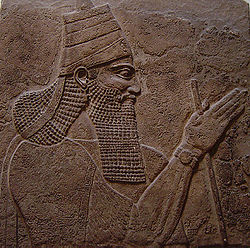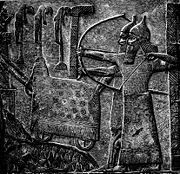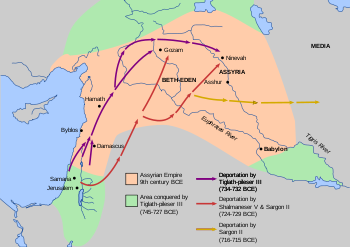
Tiglath-Pileser III
Encyclopedia

Assyria
Assyria was a Semitic Akkadian kingdom, extant as a nation state from the mid–23rd century BC to 608 BC centred on the Upper Tigris river, in northern Mesopotamia , that came to rule regional empires a number of times through history. It was named for its original capital, the ancient city of Assur...
in the eighth century BC (ruled 745–727 BC) and is widely regarded as the founder of the Neo-Assyrian Empire.
Tiglath-Pileser III seized the Assyrian throne during a civil war and killed the royal family. He made sweeping changes to the Assyrian government, considerably improving its efficiency and security. Assyrian forces became a standing army. Tiglath-Pileser III subjected Babylonia
Babylonia
Babylonia was an ancient cultural region in central-southern Mesopotamia , with Babylon as its capital. Babylonia emerged as a major power when Hammurabi Babylonia was an ancient cultural region in central-southern Mesopotamia (present-day Iraq), with Babylon as its capital. Babylonia emerged as...
to tribute, severely punished Urartu
Urartu
Urartu , corresponding to Ararat or Kingdom of Van was an Iron Age kingdom centered around Lake Van in the Armenian Highland....
(Armenia), and defeated the Medes
Medes
The MedesThe Medes...
and the Hittites
Hittites
The Hittites were a Bronze Age people of Anatolia.They established a kingdom centered at Hattusa in north-central Anatolia c. the 18th century BC. The Hittite empire reached its height c...
. He reconquered Syria
Syria
Syria , officially the Syrian Arab Republic , is a country in Western Asia, bordering Lebanon and the Mediterranean Sea to the West, Turkey to the north, Iraq to the east, Jordan to the south, and Israel to the southwest....
(destroying Damascus
Damascus
Damascus , commonly known in Syria as Al Sham , and as the City of Jasmine , is the capital and the second largest city of Syria after Aleppo, both are part of the country's 14 governorates. In addition to being one of the oldest continuously inhabited cities in the world, Damascus is a major...
) and the Mediterranean seaports of Phoenicia
Phoenicia
Phoenicia , was an ancient civilization in Canaan which covered most of the western, coastal part of the Fertile Crescent. Several major Phoenician cities were built on the coastline of the Mediterranean. It was an enterprising maritime trading culture that spread across the Mediterranean from 1550...
. Tiglath-Pileser III also occupied Philistia and Israel
Israel
The State of Israel is a parliamentary republic located in the Middle East, along the eastern shore of the Mediterranean Sea...
. Later in his reign, Tiglath-Pileser III assumed total control of Babylonia.
Tiglath-Pileser III discouraged revolts against Assyrian rule, with the use of forced deportations of thousands of people all over the empire. He is considered to be one of the most successful military commanders in world history, conquering most of the world known to the Assyria
Assyria
Assyria was a Semitic Akkadian kingdom, extant as a nation state from the mid–23rd century BC to 608 BC centred on the Upper Tigris river, in northern Mesopotamia , that came to rule regional empires a number of times through history. It was named for its original capital, the ancient city of Assur...
ns before his death.
Origins
Former governor of Kalhu and a general, Pulu was a usurper who assumed his Assyrian throne name from two more legitimate predecessors. He described himself as a son of Adad-nirari IIIAdad-nirari III
Adad-nirari III was King of Assyria from 811 to 783 BC. He was the son and successor of Shamshi-Adad V, and was apparently quite young at the time of his accession, because for the first five years of his reign his mother Shammuramat acted as regent, which may have given rise to the legend of...
in his inscriptions, but it is uncertain if this is truthful. He seized the throne in the midst of civil war on 13 Ayaru, 745 BC. As a result of Pulu seizing the throne in a bloody coup d'état
Coup d'état
A coup d'état state, literally: strike/blow of state)—also known as a coup, putsch, and overthrow—is the sudden, extrajudicial deposition of a government, usually by a small group of the existing state establishment—typically the military—to replace the deposed government with another body; either...
, the royal family was slaughtered, and Assyria was set on the path to empire
Imperialism
Imperialism, as defined by Dictionary of Human Geography, is "the creation and/or maintenance of an unequal economic, cultural, and territorial relationships, usually between states and often in the form of an empire, based on domination and subordination." The imperialism of the last 500 years,...
in order to ensure the survival of the kingdom.
Reign

Near East
The Near East is a geographical term that covers different countries for geographers, archeologists, and historians, on the one hand, and for political scientists, economists, and journalists, on the other...
greatly increased as the result of Tiglath-Pileser's military reforms (see "Reforms" below) and his campaigns of conquest. Upon ascending the throne, he claimed (in Annal 9, which dates to 745 BC, his first regnal year
Regnal year
A regnal year is a year of the reign of a sovereign, from the Latin regnum meaning kingdom, rule.The oldest dating systems were in regnal years, and considered the date as an ordinal, not a cardinal number. For example, a monarch could have a first year of rule, a second year of rule, a third, and...
) to have annexed
Annexation
Annexation is the de jure incorporation of some territory into another geo-political entity . Usually, it is implied that the territory and population being annexed is the smaller, more peripheral, and weaker of the two merging entities, barring physical size...
Babylonia, from "Dur-(Kuri)galzu, Sippar of Shamash, ... the cities [of Ba]bylonia up to the Uqnu river [by the shore of the Lo]wer [Sea]" (which referred to the Persian Gulf), and subsequently placed his eunuch
Eunuch
A eunuch is a person born male most commonly castrated, typically early enough in his life for this change to have major hormonal consequences...
over them as governor. Also in his first year of reign he defeated the powerful kingdom of Urartu
Urartu
Urartu , corresponding to Ararat or Kingdom of Van was an Iron Age kingdom centered around Lake Van in the Armenian Highland....
(in modern Armenia
Armenia
Armenia , officially the Republic of Armenia , is a landlocked mountainous country in the Caucasus region of Eurasia...
), whose hegemony under the rulership of Sarduri II
Sarduri II
Sarduri II was the King of Urartu . The Urartian Kingdom was at its peak during his reign. He succeeded his father Argishti I to the throne....
had extended to Asia Minor, northern Mesopotamia,western Iran and Syria; there he found unrivalled horses for his war-chariots. He also defeated the Medes
Medes
The MedesThe Medes...
before making war on and conquering the Neo-Hittite
Neo-Hittite
The states that are called Neo-Hittite, or more recently Syro-Hittite, were Luwian, Aramaic and Phoenician-speaking political entities of the Iron Age northern Syria and southern Anatolia that arose following the collapse of the Hittite Empire around 1180 BC and lasted until roughly 700 BC...
s, Syria
Syria
Syria , officially the Syrian Arab Republic , is a country in Western Asia, bordering Lebanon and the Mediterranean Sea to the West, Turkey to the north, Iraq to the east, Jordan to the south, and Israel to the southwest....
and Phoenicia
Phoenicia
Phoenicia , was an ancient civilization in Canaan which covered most of the western, coastal part of the Fertile Crescent. Several major Phoenician cities were built on the coastline of the Mediterranean. It was an enterprising maritime trading culture that spread across the Mediterranean from 1550...
. He took Arpad
Arpad (Syria)
Arpad was an ancient Aramaean city located in north-western Syria, north of Aleppo. In 743 BC, the Assyrian king Tiglath-pileser III led a military expedition to Syria, defeating there the Uraratian army. But the city of Arpad, which had formed an alliance with Urartu, did not surrender easily...
in 740 BC after three years of siege, annexed it as a province (over which he placed one of his eunuchs as governors), and subjected Hamath to tribute. Assyrian inscriptions record in 740 BC, the fifth year of his reign, a victory over Azariah (Uzziah
Uzziah of Judah
Uzziah , also known as Azariah , was the king of the ancient Kingdom of Judah, and one of Amaziah's sons, whom the people appointed to replace his father...
), king of Judah
Kingdom of Judah
The Kingdom of Judah was a Jewish state established in the Southern Levant during the Iron Age. It is often referred to as the "Southern Kingdom" to distinguish it from the northern Kingdom of Israel....
, whose achievements are described in 2 Chronicles 26.He also subjugated Damascus, the Arabs under Queen Zabibe, Menahem
Menahem
Menahem, was a king of the northern Israelite Kingdom of Israel. He was the son of Gadi, and the founder of the dynasty known as the House of Gadi or House of Menahem....
of Israel
Israel
The State of Israel is a parliamentary republic located in the Middle East, along the eastern shore of the Mediterranean Sea...
and Sam'al
Sam'al
Sam'al was a Hittite and Aramaean city located at Zincirli Höyük in the Anti-Taurus Mountains of modern Turkey's Gaziantep Province.-History:thumb|200px|right|Historical map of the Neo-Hittite states, ca...
's king Azriyau, who all paid him tribute. In 737 and 736 BC he turned his attention again to Iran, conquering the Medes
Medes
The MedesThe Medes...
and Persians
Persian people
The Persian people are part of the Iranian peoples who speak the modern Persian language and closely akin Iranian dialects and languages. The origin of the ethnic Iranian/Persian peoples are traced to the Ancient Iranian peoples, who were part of the ancient Indo-Iranians and themselves part of...
and occupying a large part of Iran. According to the royal inscriptions of Tiglath-Pileser many of the inhabitants were enslaved and deported to other parts of the Assyrian empire, as commonly done by his predecessors. At sieges captives were slaughtered and their bodies raised on stakes and displayed before the city (illustration, right).
In October 729 BC , Tiglath-Pileser assumed total control of Babylon, capturing the Babylonian king Nabu-mukin-zeri (ABC 1 Col.1:21) and having himself crowned as "King Pulu of Babylon".
Biblical records

Menahem
Menahem, was a king of the northern Israelite Kingdom of Israel. He was the son of Gadi, and the founder of the dynasty known as the House of Gadi or House of Menahem....
of Israel (2 Kings 15:19) and defeated his successor Pekah
Pekah
Pekah was king of Israel. He was a captain in the army of king Pekahiah of Israel, whom he killed to become king. Pekah was the son of Remaliah ....
(15:29). Pekah had allied with Rezin
Rezin
King Rezin of Aram or Rasin of Syria in DRB ruled from Damascus during the 8th century BC. During his reign he was a tributary of King Tiglath-pileser III of Assyria....
, king of the Arameans against Ahaz
Ahaz
Ahaz was king of Judah, and the son and successor of Jotham. He is one of the kings mentioned in the genealogy of Jesus in the Gospel of Matthew....
(known to the Assyrians as Yahu-khazi), king of Judah
Kingdom of Judah
The Kingdom of Judah was a Jewish state established in the Southern Levant during the Iron Age. It is often referred to as the "Southern Kingdom" to distinguish it from the northern Kingdom of Israel....
, who responded by appealing for the Assyrian monarch's help with the Temple
Solomon's Temple
Solomon's Temple, also known as the First Temple, was the main temple in ancient Jerusalem, on the Temple Mount , before its destruction by Nebuchadnezzar II after the Siege of Jerusalem of 587 BCE....
gold and silver. Tiglath-Pileser complied by seizing Damascus
Damascus
Damascus , commonly known in Syria as Al Sham , and as the City of Jasmine , is the capital and the second largest city of Syria after Aleppo, both are part of the country's 14 governorates. In addition to being one of the oldest continuously inhabited cities in the world, Damascus is a major...
, executing Rezin, and deporting the Aramaean inhabitants to Kir
Kir
Kir is a popular French cocktail made with a measure of crème de cassis topped up with white wine.In France it is usually drunk as an apéritif before a meal or snack. Originally the wine used was Bourgogne Aligoté, a lesser white wine of Burgundy. Nowadays, various white wines are used throughout...
(16:9). He also seized the northern half of Israel, and deported the Reubenites, Gadites, and Manasseh to Halah, Habor, Hara, and the Gozan river (1 Chron. 5:26). Beyond this, the alliance was not beneficial to Ahaz. (2 Chron 28:20).
Reforms
Upon ascending the throne, Tiglath-Pileser instituted several reforms to different sectors of the Assyrian state, which arguably revived Assyria's hegemony over the Near East.The first of such reforms entailed thwarting the powers of the high Assyrian officials, which during the reigns of his predecessors had become excessive. Officials such as Šamši-ilu, who was turtanu and a prominent official since the time of Adad-Nirari III, often led their own campaigns and erected their own commemorative stelae
Stele
A stele , also stela , is a stone or wooden slab, generally taller than it is wide, erected for funerals or commemorative purposes, most usually decorated with the names and titles of the deceased or living — inscribed, carved in relief , or painted onto the slab...
, often without mentioning the king at all. Since his earliest inscriptions (and thus from the beginning of his reign), he gave regular mention of appointing eunuch
Eunuch
A eunuch is a person born male most commonly castrated, typically early enough in his life for this change to have major hormonal consequences...
s as governors of (newly conquered) provinces; this removed the threat of provincial rule becoming a dynastic
Dynasty
A dynasty is a sequence of rulers considered members of the same family. Historians traditionally consider many sovereign states' history within a framework of successive dynasties, e.g., China, Ancient Egypt and the Persian Empire...
matter. He also sought to reduce the power of his officials by reducing the size of the provinces (in some cases the northern provinces were increased to include newly conquered territories), thus decreasing their resources, should they have desired to incite a revolt. Subsequently, there were more provinces, more governors (most of which were eunuchs), and less power per governor.
The second reform targeted the army. Instead of a largely native Assyrian army which normally campaigned only in the summer time, Tiglath-Pileser incorporated large numbers of conquered people into the army, thus adding a substantial foreign element. This force mainly comprised the infantry, whereas the native Assyrians comprised the cavalry and chariotry. As a result of Tiglath-Pileser's military reforms, the Assyrian Empire was armed with a greatly expanded army which could campaign throughout the year. The addition of the cavalry and the chariot contingents to the army was mostly due to the steppe cultures lurking nearby to the north, which sometimes invaded their northern lands, using mainly cavalry and primitive chariots.
Legacy
Tiglath-Pileser III's conquests and reforms led to the establishment of the Neo-Assyrian KingdomAssyria
Assyria was a Semitic Akkadian kingdom, extant as a nation state from the mid–23rd century BC to 608 BC centred on the Upper Tigris river, in northern Mesopotamia , that came to rule regional empires a number of times through history. It was named for its original capital, the ancient city of Assur...
as a true empire. He built a royal palace in Nimrud
Nimrud
Nimrud is an ancient Assyrian city located south of Nineveh on the river Tigris in modern Ninawa Governorate Iraq. In ancient times the city was called Kalḫu. The Arabs called the city Nimrud after the Biblical Nimrod, a legendary hunting hero .The city covered an area of around . Ruins of the city...
(the so-called "central palace"), later dismantled by Esarhaddon
Esarhaddon
Esarhaddon , was a king of Assyria who reigned 681 – 669 BC. He was the youngest son of Sennacherib and the Aramean queen Naqi'a , Sennacherib's second wife....
. He had his royal annals engraved across the bas-reliefs depicting his military achievements on the sculptured slabs decorating his palace.
On his death he was succeeded by his son Ululayu, who took the name Shalmaneser V
Shalmaneser V
Shalmaneser V was king of Assyria from 727 to 722 BC. He first appears as governor of Zimirra in Phoenicia in the reign of his father, Tiglath-Pileser III....
and further campaigned in the Levant, and captured Samaria
Samaria
Samaria, or the Shomron is a term used for a mountainous region roughly corresponding to the northern part of the West Bank.- Etymology :...
.

